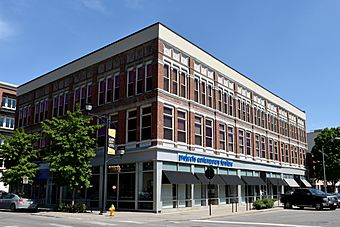Syndicate Block (Des Moines, Iowa) facts for kids
Quick facts for kids |
|
|
Syndicate Block
|
|
|
U.S. Historic district
Contributing property |
|
 |
|
| Location | 501 E. Locust St. Des Moines, Iowa |
|---|---|
| Area | less than one acre |
| Built | 1883 |
| Architectural style | Renaissance Revival |
| Part of | East Des Moines Commercial Historic District (ID100003523) |
| NRHP reference No. | 01001059 |
| Added to NRHP | October 1, 2001 |
The Syndicate Block, also known as the McCoy Building, is an old and important building in the East Village area of Des Moines, Iowa, United States. It was added to a special list of important places, the National Register of Historic Places, in 2001. Later, in 2019, the building was also recognized as an important part of the East Des Moines Commercial Historic District.
A Look Back in Time
The land where the Syndicate Block stands was first owned by Conrad Dietz. He was a German farmer who moved to Polk County in 1847, making him one of the area's first settlers.
In 1876, Mr. Dietz sold one part of his land to the owners of a hardware store called Entwistle & O’Dea. He rented out the rest of his land to other shopkeepers and people who made things by hand.
By 1883, there were many small wooden buildings on the property. They were near the corner of Fifth and Locust Streets and looked like a busy street in a small town.
Building the Syndicate Block
A group of business people from the East Side of Des Moines decided to build a new, bigger building in 1883. This three-story brick building was constructed only a few blocks from the Iowa State Capitol.
The building was designed in the Renaissance Revival style. This means it looks like buildings from the European Renaissance period, which was a time of great art and learning. It really stood out because many other buildings nearby were in the Italianate style, which has different features like tall windows.
Over the years, the first floor of the Syndicate Block has been home to many different shops. The upper floors have been used as offices for various jobs and companies. Today, the building still has several businesses operating inside.



